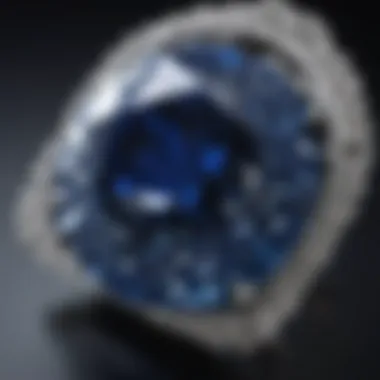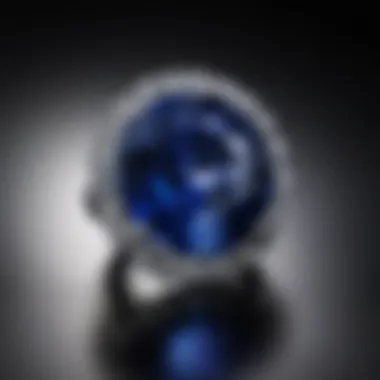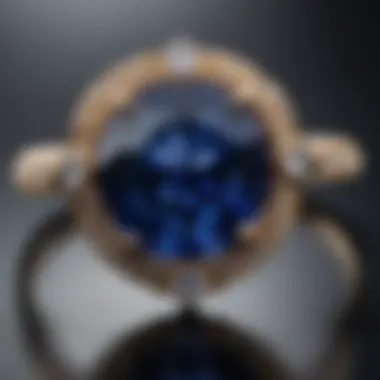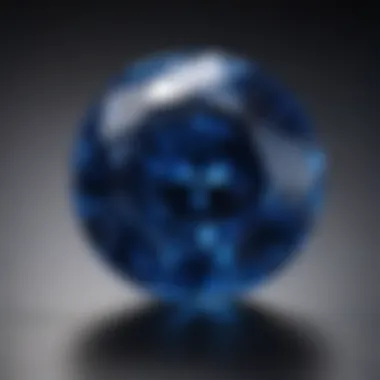The Allure of 2.5 Carat Sapphires Explained


Intro
The fascination with sapphires has a long history, celebrated not just for their beauty but also for their unique compositions and cultural significance. When one thinks about gemstones, 2.5 carat sapphires often emerge as a point of interest for collectors, jewelry designers, and enthusiasts alike. This section will explore what sets a 2.5 carat sapphire apart from other gemstones in the market, both from a scientific and aesthetic perspective.
Gemstone Overview
Description of the gemstone
A 2.5 carat sapphire is more than just a stone. It embodies brilliant hues and symbolizes a range of meanings. This gemstone, primarily composed of corundum, gains its color from trace elements such as iron, titanium, and chromium. The most sought-after sapphires exhibit a rich blue hue; however, they can also be found in a variety of colors, including pink, yellow, and white. Each hue carries its own significance and appeal.
Physical properties
The physical properties of sapphires are essential to understand their value in the market. Here are some notable characteristics:
- Mohs Hardness: Sapphires score a 9 on the Mohs scale, making them one of the hardest gemstones available.
- Refractive Index: The refractive index ranges between 1.76 and 1.77, providing a remarkable brilliance that enhances their visual appeal.
- Specific Gravity: Sapphires have a specific gravity of approximately 3.95 to 4.03.
- Pleochroism: Certain sapphires display different colors when viewed from different angles, showcasing their complexity.
Sapphire is not only a gemstone; it is a masterpiece of nature, combining rarity, beauty, and durability.
Healing Properties
Metaphysical attributes
While the scientific properties of sapphires are impressive, many also attribute metaphysical qualities to them. Some believe that sapphires promote mental clarity, inspire creativity, and encourage a sense of calmness in those who wear them. Their tranquil presence is thought to facilitate wisdom and insight, making them a favored choice for meditation and spiritual practices.
Common uses in holistic practices
In various holistic practices, sapphires are used for their purported healing abilities:
- Meditation: Many individuals use sapphires during meditation to enhance focus and peace.
- Chakra Healing: The stone is often associated with the throat and third eye chakras, where it is believed to assist in communication and intuition.
- Crystal Healing: Practitioners use sapphires in crystal healing sessions, claiming they help in emotional balance and clarity.
The allure of a 2.5 carat sapphire is thus not only due to its aesthetic beauty but also its deeper significance in various contexts, making it a worthwhile exploration for enthusiasts and professionals in the gemstone market.
Prelude to Sapphires
Sapphires are gemstones that have captivated humanity for centuries. Their rich colors and exceptional durability make them not only a favorite among jewelers but also significant in various cultural contexts. In this article, we delve into the specifics of the 2.5 carat sapphire, exploring its unique attributes and market relevance. An understanding of sapphires is essential for enthusiasts, collectors, and designers. Knowing the nuances helps in making informed decisions when acquiring these precious stones.
The Importance of Carat Weight
Carat weight is a critical factor when assessing gemstones. It reflects not only the size of the stone but also its rarity and market value. A 2.5 carat sapphire sits in a desirable range. This size strikes a balance; it is big enough to capture attention without being excessively large, making it suitable for various types of jewelry. Larger sapphires are rarer, thus increasing their desirability. However, even smaller carat weights can be stunning and valuable, depending on other attributes like color and clarity.
In a marketplace flooded with options, understanding carat weight aids buyers in setting realistic expectations when it comes to budget and quality. This is particularly useful for those who are new to purchasing gemstones. In brief, the carat weight of a sapphire is an essential element that influences its market narrative.
Overview of Sapphire Types
Sapphires come in various types, classified primarily by their color but also by their origin and treatment. The most recognized type is the blue sapphire, renowned for its deep hue. However, sapphires can exhibit a spectrum of colors including pink, yellow, and even white.
Some sapphires display a phenomenon known as color change, appearing differently based on lighting conditions. This adds to their appeal and uniqueness. Additionally, sapphires are often categorized into commercial and fine grades. Commercial-grade sapphires are typically more available and affordable. In contrast, fine-grade sapphires are those that exhibit exceptional qualities in color and clarity.
Understanding these classifications can enhance one's appreciation for sapphires, guiding both purchasing decisions and personal preferences. Knowing the different types also aids collectors in identifying valuable specimens beyond mere aesthetics.
Geological Formation of Sapphires
The geological formation of sapphires plays a central role in understanding these gemstones. This segment delves into how sapphires form, the elements that contribute to their unique characteristics, and the implications for both collectors and jewelry designers. Knowledge of sapphire formation can enhance appreciation of these gemstones and inform decisions when purchasing or sourcing sapphires.
Origin of Sapphire Crystals
Sapphire crystals originate from corundum, a mineral composed primarily of aluminum oxide. The specific conditions required for sapphire formation include extreme pressure and heat deep within the Earth’s crust, typically at depths of 40 to 100 kilometers. During the cooling process, trace elements such as iron, titanium, and chromium can enter the crystal structure, which results in varying colors and properties. The most coveted sapphires are often blue, a result of titanium and iron's presence in the corundum.
Sapphires can be classified based on their color, clarity, and other qualities. A closer look reveals:
- Blue sapphires, prized for their intense color.
- Fancy sapphires, which can be pink, yellow, or green depending on impurities.
- Color-change sapphires, that display different colors under different lighting.


Understanding the geological origin gives insight into each stone's character. Factors such as the temperature, pressure, and mineral content during formation can impact not only the color but also the clarity of sapphires.
Mining Locations
Sapphires are mined in various locations around the world. Each mining site contributes distinct features to the sapphires it produces, making these gemstones unique. The primary mining regions include:
- Kashmir, India: Known for its romanticised rich blue sapphires. The local geology provides a unique environment which leads to a richness in color.
- Montana, USA: Home to a variety of colors, including blue and yellow sapphires, Montana's geological formations yield stones with a range of characteristics.
- Sri Lanka: This island is a significant source for high-quality blue sapphires as well as the famed star sapphires. The geology here lends to clarity and vibrant color.
- Myanmar (Burma): Famous for its deep blue sapphires, the country is historically significant for producing noteworthy gemstones.
"The location where sapphires are mined often reflects not just the beauty of the stone, but also its value in the market."
Each region’s geological makeup influences the quality and appearance of the sapphires extracted. Therefore, understanding mining locations helps collectors and potential buyers assess the quality of sapphires on the market.
Evaluating a 2. Carat Sapphire
Evaluating a 2.5 carat sapphire requires attention to intricate details. This process is crucial for collectors, jewelry designers, and enthusiasts alike. The value of a sapphire is not solely determined by its carat weight. Instead, it involves several factors such as color, clarity, cut, and carat weight. Each of these elements plays a significant role in defining the sapphire's overall appeal and market price.
Factors Affecting Value
Color
Color is one of the most critical aspects when evaluating a sapphire. It encompasses the hue, tone, and saturation. A vivid, deep blue is often the most sought-after and valued. This coloration can fetch higher prices compared to lighter shades. The unique feature of sapphire color is its capacity to reflect different shades depending on the light source.
Benefits of a well-colored sapphire include enhanced allure and potential for value appreciation. However, it is essential to note that hues can vary significantly. Some collectors might prefer sapphires with unique colors, such as pink or yellow. This diversity gives buyers options, but it also makes selecting the right color challenging.
Clarity
Clarity refers to the absence of inclusions and blemishes in a gemstone. High clarity signifies that the sapphire has fewer internal flaws, making it more desirable. Clarity affects not just the beauty but also the value of a sapphire. A flawless or near-flawless sapphire can command a premium price.
One unique characteristic of clarity is its visible impact when evaluating the stone in different lighting. Enhanced clarity improves the ability of the sapphire to reflect light beautifully. However, lower clarity sapphires, while potentially less expensive, can also offer interesting patterns and looks that some buyers might find appealing.
Cut
The cut of a sapphire plays a vital role in its overall appearance. A well-executed cut enhances brilliance and sparkle by allowing more light to enter the stone. This key characteristic of the cut can amplify the sapphire's color and clarity. Various cut styles, such as oval, round, or pear, offer different aesthetics.
The unique feature of the cut is that it can alter the perception of a sapphire's size. A well-cut stone may appear larger than its actual carat weight suggests. While a poor cut can lead to dullness, an excellent cut maximizes the sapphire's beauty. Thus, cut influences both visual appeal and market value significantly.
Carat Weight
Carat weight is the measure that indicates how heavy a sapphire is. For many buyers, higher carat weight can be more appealing, particularly up to a certain point. In the case of 2.5 carats, it represents a substantial size without reaching the higher price brackets seen in larger stones. This weight often balances desirability and cost-effectiveness.
One unique aspect of carat weight is the pricing structure; it is not always linear. For example, a sapphire that is just slightly above a significant weight, such as 3 carats, can experience a substantial price jump. Therefore, buyers must consider carat weight carefully in conjunction with the other evaluated factors.
Certification and Authenticity
Certification provides assurance regarding the quality and authenticity of a sapphire. It documents details about the stone's properties, including its origins. Reputable grading institutions like the Gemological Institute of America (GIA) offer certifications that are widely recognized in the market.
Buying a sapphire without certification can be risky. It increases the chance of purchasing a treated or synthetic gemstone without knowing. Ensuring the stone's authenticity helps to secure its value and quality for both long-term investment and decorative purposes.
"In the gemstone market, informed choices about evaluation lead to better purchases and investments. It is most vital to understand each specific factor that contributes to the value of sapphires."
Sapphire Treatments and Enhancements
Sapphire treatments and enhancements play a significant role in both the market value and aesthetic appeal of sapphires. Understanding these processes is essential for collectors, jewelry designers, and gem enthusiasts, as they can significantly influence the gemstone's visual quality and overall worth. Treatments are implemented to improve a sapphire's appearance, making it more desirable in the eyes of consumers and investors alike. Here, we will explore common treatment methods, their identifying features, and implications for the buyer.
Common Treatment Methods
Heat Treatment
Heat treatment stands out as the most common method used to enhance sapphires. This process involves subjecting the gemstone to elevated temperatures in a controlled environment. The main goal of heat treatment is to improve the color and clarity of the sapphire, making it more visually appealing. One key characteristic of heat treatment is its ability to intensify the inherent color of sapphires, transforming pale stones into rich, vibrant hues.
One unique feature of heat treatment is its relatively permanent effect. When performed correctly, it can lead to a stable enhancement that does not diminish over time. It is a beneficial choice because it increases the marketability of the gemstone without compromising its identity. However, there are some drawbacks; not all sapphires can withstand heat, and incorrect processes can lead to damage or unwanted color changes.


Clarity Enhancement
Clarity enhancement is another treatment method employed to improve the appearance of sapphires. This technique typically involves the use of oils or resins to fill surface-reaching inclusions or cracks. By doing so, the sapphire appears clearer and more brilliant. A defining characteristic of clarity enhancement is its immediate visual impact; it can dramatically improve the gemstone's clarity and brightness.
This method is popular among sellers as it can make gemstones that would otherwise be considered low-quality more appealing to buyers. However, it also comes with certain disadvantages. The enhancements can be sensitive to cleaning agents or high heat, requiring careful maintenance. Buyers must be aware that clarity-enhanced sapphires may have a lower resale value, as the enhancement could be viewed as a treatment rather than a natural characteristic.
Identifying Treated Sapphires
Identifying treated sapphires is an important consideration when purchasing or evaluating a gemstone. Several techniques exist to distinguish between treated and untreated sapphires. A reputable gemologist can use advanced tools such as magnification and spectroscopy to detect signs of treatments. For instance, the presence of bubbles in oil-filled inclusions indicates clarity enhancement. Additionally, heat-treated stones often display certain color zoning characteristics that differ from untreated specimens.
A potential buyer should always seek certificates from recognized laboratories that specifically mention any treatment methods applied to the sapphire. This documentation serves as a vital resource for understanding the quality and authenticity of the gemstone. In summary, knowledge of treatments and how to identify them is crucial for making informed decisions in the sapphire market.
Cultural Significance of Sapphires
The cultural significance of sapphires extends beyond mere aesthetic appeal. Sapphires have captivated human imagination for centuries and occupy a special place in history, religion, and art. Understanding this cultural dimension is crucial for collectors, enthusiasts, and jewelry designers who appreciate not only the beauty but also the heritage behind these gemstones.
Historical Context
Sapphires have been valued since ancient times. Historical records show their use among nobility and clergy, often symbolizing power and wisdom. Ancient civilizations, including the Greeks and Romans, believed that sapphires brought protection to the wearer, offering both physical and spiritual safety.
In the Middle Ages, sapphires became associated with the divine. Clergy adorned themselves with these stones, as they were thought to strengthen faith and intellect. Kings and queens wore sapphires to symbolize their rank and to invoke protection from evil. Amidst this rich heritage, sapphires also played a key role in royal engagements, with notable examples like the 1981 engagement ring of Diana, Princess of Wales, which features a stunning sapphire surrounded by diamonds.
Furthermore, various cultures have unique tales associated with sapphires, often linking them to celestial bodies, grounding their earthly beauty with cosmic significance.
Symbolism and Folklore
Sapphires carry profound symbolic meanings. In many cultures, they signify truth, loyalty, and sincerity. Their deep blue hue is often equated with heaven and spirituality, fostering a connection between the earthly realm and celestial one. This spirituality resonates strongly within religious artifacts and royal insignia.
In folklore, sapphires are tied to myths that reveal their supposed power. This includes beliefs that sapphires can bring peace, calm emotions, and enhance intuition. In some parts of the world, they are thought to provide foresight, protecting the wearer from harm or misfortune.
"The rich history and symbolism associated with sapphires make them not just jewelry but rather heirlooms that carry stories and sentiments."
The gemstone is also used in various cultural rituals. For example, in Hinduism, sapphires are linked to Saturn, and wearing them is considered auspicious for those facing challenging planetary influences. This diverse array of beliefs highlights the sapphire's important place in global folklore, enriching its significance far beyond the realm of aesthetics.
In summary, grasping the cultural significance of sapphires enhances the overall appreciation of these gemstones. Understanding their historical context and the plethora of symbolic meanings offers collectors and enthusiasts deeper insights into the allure of a 2.5 carat sapphire.
Sapphire in Jewelry Design
Sapphire's role in jewelry design is significant. Its unique color, variety of settings, and cultural meanings make it highly sought after in the jewelry industry. A 2.5 carat sapphire stands out not only for its weight but also for its brilliance. This section explores critical elements and considerations that every buyer and designer should know when selecting a sapphire for jewelry.
Choosing the Right Setting
The setting of a sapphire is crucial to its overall appeal. Different settings can enhance or diminish the beauty of the stone. Here are some important points to consider when deciding on the right setting for a 2.5 carat sapphire:
- Type of Metal: Consider the metal used in the setting, as it can significantly affect the look of the sapphire. Common metals include white gold, yellow gold, and platinum. Each metal can bring out different tones in the sapphire.
- Style of Setting: Various styles exist, such as solitaire, halo, and vintage. A solitaire setting allows the sapphire to be the focal point, while a halo design may include smaller diamonds to accentuate the main stone.
- Security of the Stone: A well-designed setting must secure the sapphire properly. Ensure that prongs or settings adequately protect the stone from loosening or damage.
- Comfort and Wearability: If the design is for everyday wear, choose a setting that is comfortable. Also, consider how the design fits into the wearer’s lifestyle.
By carefully selecting the right setting, designers and buyers can enhance the sapphire’s natural beauty and ensure its durability.
Popular Design Styles
When it comes to popular design styles for sapphires, there are several trends that stand out. These styles reflect both contemporary and traditional preferences:
- Solitaire Rings: These elegant rings feature a single sapphire, allowing it to shine in its simplicity. This design is timeless and appeals to many buyers.
- Three-Stone Settings: Often symbolizing the past, present, and future, these rings typically feature a central sapphire flanked by two smaller gems. This style offers a beautiful visual balance.
- Vintage Designs: Vintage or antique-inspired designs have risen in popularity. They often incorporate intricate detailing and unique stone cuts that speak to historical craftsmanship.
- Sapphire Engagement Rings: The trend for engagement rings featuring sapphires instead of traditional diamonds has grown. They offer a unique alternative for couples seeking something different.
The design styles chosen ultimately reflect personal taste. Consideration of current trends, along with the unique attributes of sapphires, leads to a well-designed piece that resonates with its wearer.
"The setting and style of a sapphire can amplify its intrinsic value and aesthetic appeal, making it a key factor in jewelry design."
In summary, understanding sapphire in jewelry design involves several factors. From choosing the right setting to recognizing popular design styles, these decisions contribute significantly to the appreciation and value of a 2.5 carat sapphire. Attention to detail ensures that each piece not only looks beautiful but also aligns with the values and preferences of the wearer.
Buying a 2. Carat Sapphire


Purchasing a 2.5 carat sapphire is an important decision for both collectors and jewelry enthusiasts. Choosing the right stone involves understanding the unique attributes that come with this specific carat weight. Sapphires in this range hold significant value due to their size, beauty, and rarity, making them sought after in the gemstone market.
When buying a 2.5 carat sapphire, one should consider factors such as quality, certification, and provenance. These characteristics directly influence the stone's value and long-term appreciation. Being informed about the market and engaging with credible sources enhances the purchasing process, ensuring that the buyer secures an authentic gem.
Another aspect to consider is the investment potential of a 2.5 carat sapphire. Well-selected sapphires can retain or even increase in value over time. Therefore, understanding where and how to purchase these gemstones is crucial.
Where to Purchase
Authorized Retailers
Buying from authorized retailers is a reliable option for potential sapphire buyers. These retailers often have established reputations in the gemstone industry and typically offer certified stones. The most significant characteristic of authorized retailers is their commitment to providing genuine sapphires, ensuring customers receive high-quality products.
Authorized retailers also provide detailed information about the sapphires they sell. This includes the gem's origins, treatment history, and certification details. The main advantage of purchasing from these sources is security. Buyers can trust that they are receiving a legitimate stone without the risk associated with unknown vendors.
However, one potential downside is the price. Authorized retailers may charge a premium for their curated selection, which may not suit all budgets.
Online Marketplaces
Online marketplaces such as eBay and Etsy present an alternative approach to purchasing 2.5 carat sapphires. These platforms connect buyers with a broader range of sellers, often at competitive prices. One main feature of online marketplaces is the ability to browse numerous listings, allowing comparisons on price, quality, and design.
While online marketplaces offer unique opportunities, they come with risks too. The authenticity and quality of stones can vary, making due diligence essential. Buyers must research sellers, look for reviews, and understand how to evaluate gemstones.
Overall, online marketplaces provide flexibility and often more budget-friendly options. However, buyers should be cautious and prepared to invest time into verifying quality and authenticity.
Tips for Buyers
When purchasing a 2.5 carat sapphire, here are some valuable tips to consider:
- Research thoroughly: Understand the market and educate yourself on sapphires, including their characteristics and variations.
- Ask for certification: Ensure that the sapphire comes with certification from reputable gemological laboratories.
- Inspect the stone: If possible, view the sapphire in person to evaluate its color, clarity, and overall appearance.
- Compare prices: Look at several sources to find the best deal without compromising quality.
- Understand return policies: Make sure you know the return and warranty terms before making a purchase.
By following these tips, buyers can navigate the complexities of the sapphire market and find a gemstone that suits their needs.
Caring for Your Sapphire
Caring for gemstones, especially a 2.5 carat sapphire, enhances their beauty and longevity. The proper care measures are essential not only to maintain the sapphire’s luster but also to protect its value. Sapphires are durable stones, but they are not impervious to damage. Regular cleaning and proper storage are fundamental for collectors and jewelry designers.
Cleaning and Maintenance
Cleaning your sapphire should be a regular practice to ensure it remains radiant. Here are several recommended methods:
- Mild Soap Solution: Create a mix of lukewarm water with a few drops of mild dish soap. Soak the sapphire in this solution for about 10 to 15 minutes. Use a soft brush, like a toothbrush, to gently clean the surface without scratching.
- Avoid Harsh Chemicals: Strong chemicals can damage the stone's surface or can affect its luster. This includes bleach, ammonia, or any abrasive home cleaning substances.
- Rinse and Dry: After cleaning, make sure to rinse the sapphire thoroughly to remove any soap residue. Dry it with a soft, lint-free cloth to avoid scratches.
Keeping your sapphire clean not only preserves its appearance but also prevents the accumulation of dirt that can dull its sparkle. Regular cleaning helps detect if there is any damage or loose settings in jewelry.
Storage Recommendations
Proper storage is just as crucial as cleaning. Here are some guidelines to keep your sapphire safe:
- Use a Soft Pouch or Box: Store your sapphire in a soft pouch or a dedicated jewelry box. This prevents scratches from other jewelry items.
- Keep Away from Other Gems: If you store multiple stones, ensure that sapphires are kept separate from harder stones like diamonds or even other sapphires.
- Avoid Direct Sunlight: While sapphires are stable, prolonged exposure to direct sunlight or extreme temperatures can lead to color changes or fissures over time. Choose a cool, dark place for storage.
- Regular Inspections: Check on your sapphire regularly to ensure it is intact and settings are secure. This step can save you from losing the stone due to a loose prong or damage.
Remember: Proper care of a sapphire extends its lifespan and keeps it looking its best, contributing to its lasting beauty.
Ending
In this article, the conclusion serves as a critical synthesis of the information provided throughout the sections. It underlines the overall significance of the 2.5 carat sapphire, emphasizing its multifaceted role in the gemstone market and its appeal to a variety of audiences. One must carefully consider the attributes that contribute to a sapphire's allure, including its geological traits, cultural history, and market value.
Sapphires are not merely beautiful stones; they carry stories of the earth’s history and human connection. As discussed, the 2.5 carat sapphire stands out due to its ideal balance of size, rarity, and aesthetic appeal. This size offers collectors and jewelry aficionados a substantial yet manageable piece for their collections or adornments. The conclusion also aims to address the careful considerations potential buyers and collectors must keep in mind. Understanding the nuances of color, clarity, cut, and treatment impacts the overall value and desirability of the sapphire. In essence, this article shows that knowledge is essential when navigating this domain. An informed decision ensures one makes a meaningful investment, whether for personal enjoyment or financial gain.
Recap of Key Points
- Significance of Carat Weight: The carat weight directly influences the value of a sapphire, with 2.5 carats being a favorable size for engagement rings and earrings.
- Value Factors: Important considerations include color, clarity, cut, and treatment methods. Each element plays a role in determining the aesthetic quality and market price.
- Mining Locations: Understanding where the sapphire is sourced enhances appreciation for its uniqueness and rarity.
- Cultural Impact: Sapphires have held different meanings across cultures, linking them to wisdom and loyalty. This can enrich the emotional connection one has with the stone.
- Maintenance: Proper care, including cleaning and storage, ensures the longevity and beauty of the sapphire.
Final Thoughts on 2. Carat Sapphires
The 2.5 carat sapphire represents a harmonious convergence of beauty, rarity, and meaning. In the realm of gemstones, it is a substantial choice that offers collectors and jewelry makers an opportunity to own a piece of nature's artwork. As highlighted, this sapphire combines adequate size with clarity and color, making it a versatile addition to any collection.
When contemplating a purchase, it is crucial to engage with reputable sellers and seek certifications. As the sapphire market continues to evolve, staying informed enables one to adapt and appreciate these magnificent gems fully. As a final note, the journey of understanding 2.5 carat sapphires can enhance one's experience, making each piece a significant element of both personal and cultural heritage.







